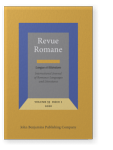Vol. 55:1 (2020) ► pp.1–33
Los verbos adimensionales
Propiedades y consecuencias
The goal of this article is the analysis of the empirical properties of change of state verbs which do not specifiy lexically the dimension where change operates – such as aumentar ‘increase’, reducir ‘reduce’, acrecentar ‘increase’ –, and also to examine the theoretical consequences that this class has for our understanding of argument structure, the distinction between light and non-light predicates and the interconnection of structural and conceptual semantics. We will show that these verbs, which we label ‘adimensional predicates’ are sharply different from prototypical change of state verbs, and we argue that their existence supports a distinction between the syntactic structure of a verb of change of state and the conceptual operation that anchors the change to a specific cognitive domain.
Article outline
- 1.Introducción: verbos de cambio sin dimensión de cambio
- 2.Una primera caracterización de los predicados adimensionales
- 2.1Los ingredientes de los verbos de cambio de estado
- 2.2Los predicados adimensionales: primera identificación
- 3.Las variantes inacusativas frente a las variantes agentivas
- 4.Propiedades y taxonomía de los verbos adimensionales
- 4.1Combinación con sintagmas nominales de dimensión
- 4.2Posición sintáctica del sintagma de dimensión
- 4.3Propiedades escalares
- 4.4Lecturas estativas
- 4.5Selección de tipos de propiedades
- 4.6Resultado: tipos de predicados adimensionales y propiedades fundamentales
- 5.Análisis: argumentos sintácticos o argumentos semánticos
- 5.1La dimensión puede introducirse como un adjunto
- 5.2Los sustantivos que aportan dimensiones no forman una clase natural en sintaxis
- 6.Consecuencias y conclusiones
- 6.1La construcción de los predicados de cambio
- 6.2La naturaleza de los predicados ligeros
- 6.3La deducción de significado y la selección sintáctica de los argumentos
- Notes
-
Referencias bibliográficas
Article language: Spanish
